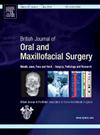Factors affecting the risk of trismus following maxillary ablative surgery comparing free flap reconstruction to prosthetic obturation: a retrospective observational study
IF 1.7
4区 医学
Q3 DENTISTRY, ORAL SURGERY & MEDICINE
British Journal of Oral & Maxillofacial Surgery
Pub Date : 2024-12-01
DOI:10.1016/j.bjoms.2024.09.005
引用次数: 0
Abstract
The reconstruction of post-ablative maxillary defects is controversial. It is accepted that quality of life indicators are poorer for maxillary reconstruction compared with mandibular reconstruction. One factor highlighted is that of post-treatment trismus. Rates of trismus are reviewed comparing free tissue transfer to that of prosthetic obturation. A retrospective review was undertaken comparing rates of trismus at twelve months post-surgery between free tissue transfer and prosthetic obturation. A total of 85 patients were identified who met the inclusion criteria. Both reconstruction techniques were significant for developing trismus, with a higher rate in the free flap reconstruction cohort than the prosthetic obturation cohort by a factor of 2.51. Modern reconstructive head and neck surgery has moved away from ‘filling a hole’ to a more bespoke, patient-specific reconstruction. The evidence presented here should allow the reconstructive surgeon to better discuss outcomes with patients when considering surgical options for Class II maxillary defects.
上颌消融手术后发生三联症风险的影响因素:一项回顾性观察研究,将游离皮瓣重建术与修复性闭合术进行比较。
上颌骨烧蚀后缺损的重建存在争议。公认的是,与下颌重建相比,上颌重建的生活质量指标较差。其中一个突出的因素是治疗后的三联症。本研究比较了游离组织转移与修复体粘固的三联症发生率。我们进行了一项回顾性研究,比较了游离组织转移术和义齿闭锁术在术后十二个月的三联症发生率。共有 85 名患者符合纳入标准。两种重建技术都会导致患者出现三联症,其中游离皮瓣重建组的三联症发生率比假体固定组高 2.51 倍。现代头颈部重建手术已从 "填洞 "转变为更加个性化、针对患者的重建。本文提供的证据应能让重建外科医生在考虑上颌骨二类缺损的手术方案时,更好地与患者讨论结果。
本文章由计算机程序翻译,如有差异,请以英文原文为准。
求助全文
约1分钟内获得全文
求助全文
来源期刊
CiteScore
3.60
自引率
16.70%
发文量
256
审稿时长
6 months
期刊介绍:
Journal of the British Association of Oral and Maxillofacial Surgeons:
• Leading articles on all aspects of surgery in the oro-facial and head and neck region
• One of the largest circulations of any international journal in this field
• Dedicated to enhancing surgical expertise.

 求助内容:
求助内容: 应助结果提醒方式:
应助结果提醒方式:


